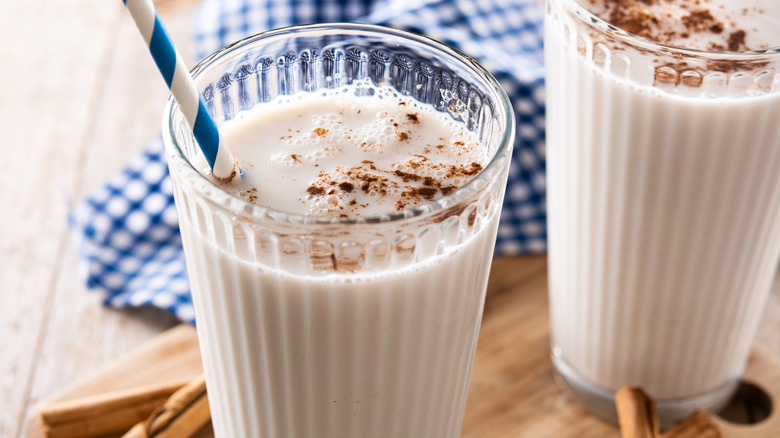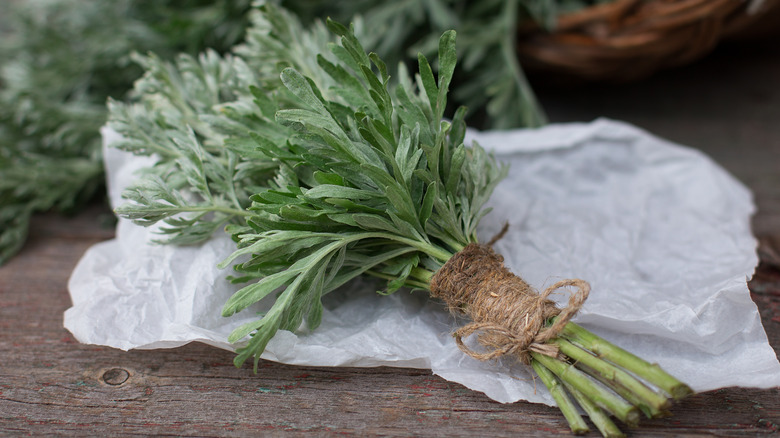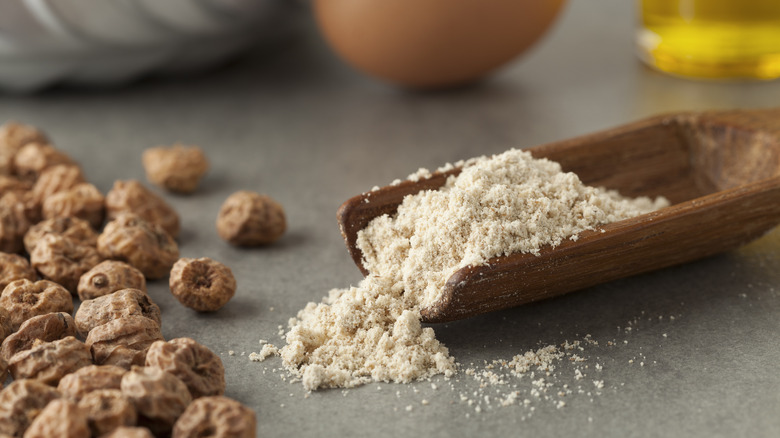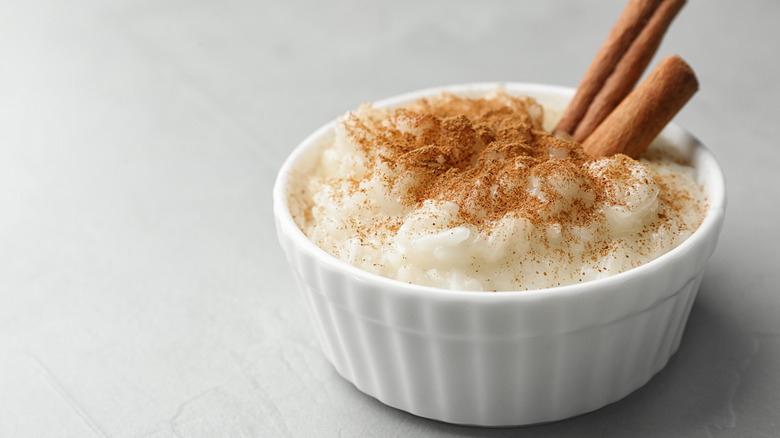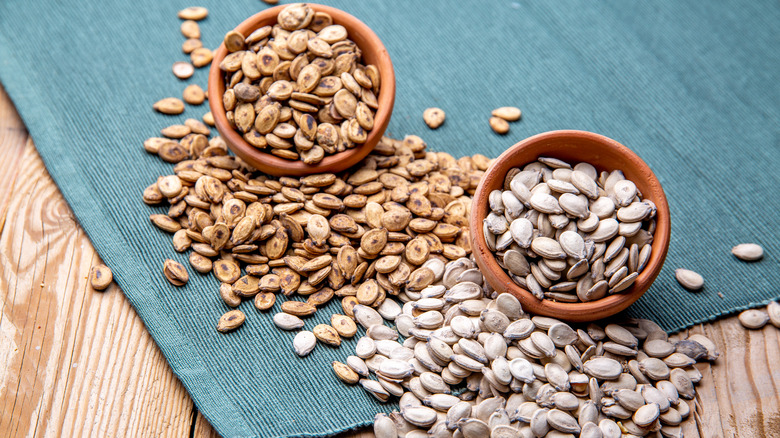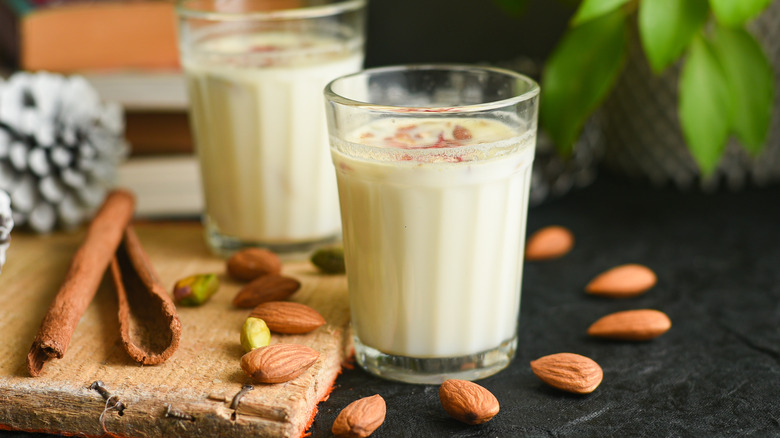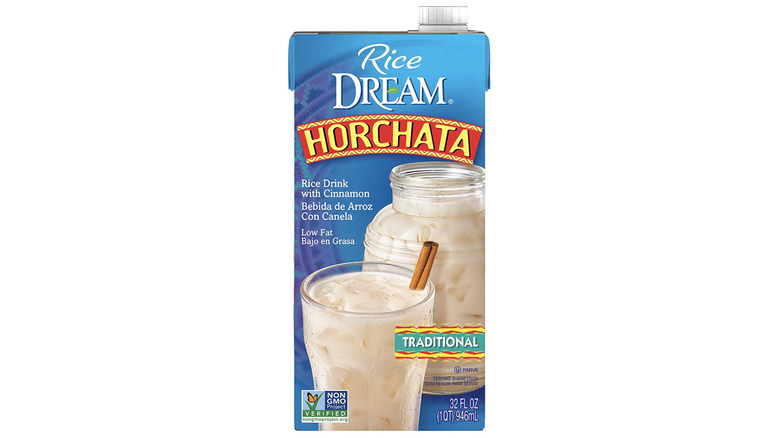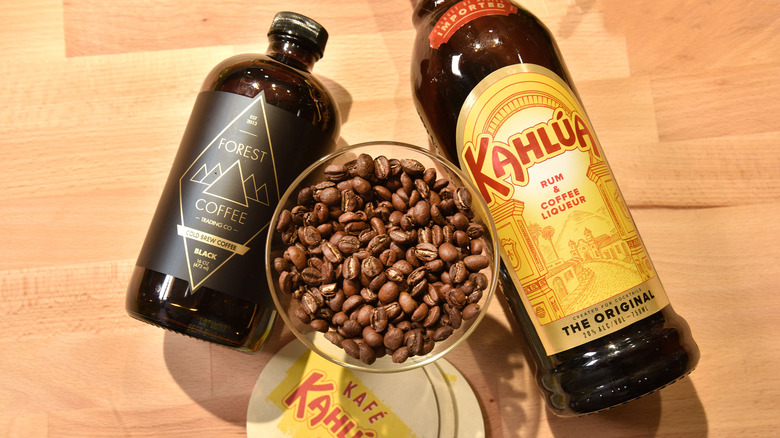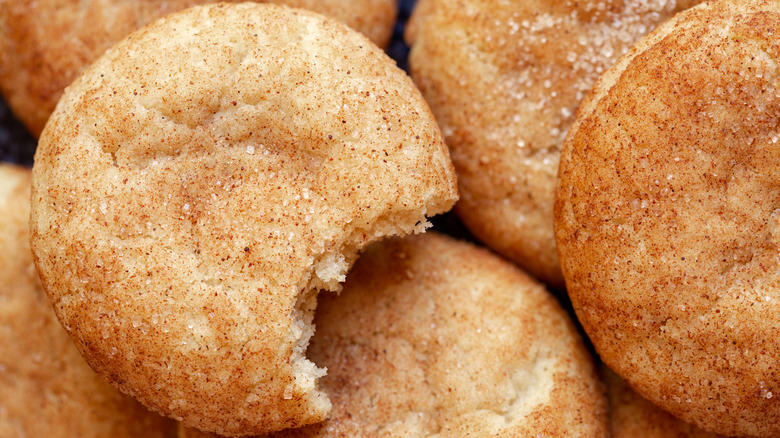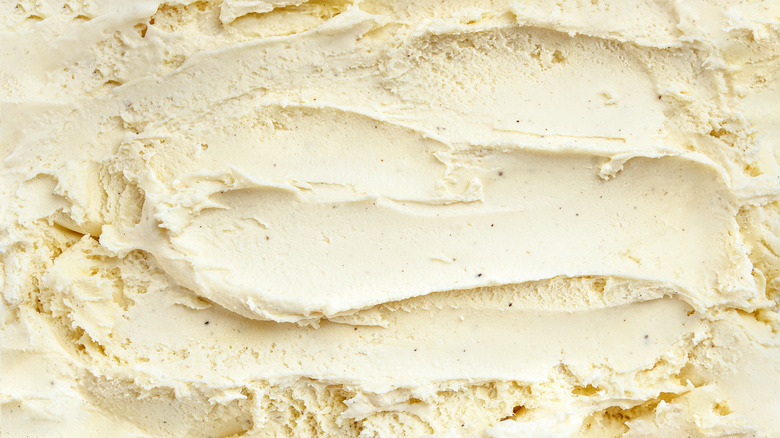The Untold Truth Of Horchata
We may receive a commission on purchases made from links.
If you've tasted horchata, then you'll know that it's a sweet, creamy, and refreshing cinnamon-flavored drink served over ice. While people commonly associate it with Mexico, many countries around the world have adopted their own versions, using a variety of methods and ingredients to create the milky base. Although it's a simple concoction, horchata is a drink that has roots dating back to ancient Egypt. Not only is it a timeless drink, but it has even been used medicinally.
Modern-day renditions of the drink have their own special twists, including vegan recipes and those spiked with booze. Some people continue to enjoy the drink cold, while others love to have it hot. Depending on how involved you want to be, you can make it from scratch or buy it premade. No matter your preference, get ready to be amazed by how much horchata has evolved over time and just how global and multigenerational it really is.
Horchata is an ancient drink dating back to 2,400 B.C.
It's hard to believe that horchata is an ancient drink when you can find it on grocery store shelves and Starbucks has made a frappuccino out of it. But its origins date back to ancient civilizations, with the earliest records of consumption in Egypt around 2,400 B.C., according to the Journal of Ethnobiology and Ethnomedicine. Interestingly, evidence of the drink's existence has even been found in Pharaoh's tombs. Early versions of this drink were made with a tuber called chufa, also known as an earth almond.
Upon conquering Egypt, Rome discovered and brought a version of the drink into their culture, making it from yellow nut grass. The Romans dubbed the drink hordeāta, which became the source of the name for Spain's ultimate rebranding as horchata. Spain began experimenting with the beverage and landed on a recipe that was prepared with barley and barley water.
Horchata originated as a medicinal drink
According to the Journal of Ethnobiology and Ethnomedicine, the indigenous populations of the Loja province in Southern Ecuador created horchata from an herbal concoction they considered to be a potent medicinal drink. This version of horchata incorporates 71 plant species that have been linked with as many as 32 therapeutic applications, according to local market vendors. The outlet explains that typically, "Each bunch of medicinal plants sold to prepare 'horchata' can vary from 16 to 32 species." Additional variation occurs since the other 39 plant species are dependent on seasonal conditions and harvests.
Health benefits reported by rural and urban people of the Loja province include improved digestion and memory, as well as anti-inflammatory effects. In the Southern Andean Highlands, locals associate the drink with invigorating spiritual effects. The association is so strong that traditionally, women in the community who were experts at growing and caring for medicinal plants were known as Horchateras.
Different countries have their own versions of the drink
Horchata hasn't had much trouble making its way around the globe and in fact, many countries have put their own unique spin on the beverage, making it a regional staple. One of the main distinctions comes from how the milky base is made, which is often dependent on what is agriculturally available for harvest.
For instance, Puerto Rico's version is named horchata de ajonjoli and uses ground sesame seeds, in addition to rum and coconut milk to make it extra creamy (via MSN). Central America has another take on the drink known as semilla de jicaro, made with the seeds from a licorice-flavored fruit called calabash. North and West Africa have their version in which tiger nuts, also known as chufas, have been soaked and ground, according to Altas Obscura. Tiger nuts look very similar to hazelnuts but aren't actually a nut at all — they're tubers. Mexico has also claimed a version of the beverage called agua fresca. This drink's milky base relies on rice soaked in water for several hours, with cinnamon added in for flavor.
The original West African horchata has health-promoting properties
Thanks to the tiger nut milk content in typical West African versions of horchata, the drink boasts a plethora of health-promoting qualities. For starters, tiger nuts are loaded with powerful antioxidants as well as being a rich source of protein, with a whopping 9 grams in a single 1-ounce serving. Since they are confusingly not a nut but a tuber, they contain resistant starch which is beneficial for digestion and gut health (via Healthline). Anecdotally, African horchata has been traditionally used for its ability to cool and reduce fevers, especially in finicky babies (per Loyal Nana).
Apart from their beneficial characteristics, tiger nuts have a natural sweetness that lends itself to horchata's flavor profile and creamy texture. In addition to the pleasant taste of the drink, it's also suitable for anyone with dietary restrictions due to nut allergies, gluten, and FODMAP sensitivities, or for vegetarians and vegans, according to Alpha Foodie.
Mexican horchata tastes like drinkable rice pudding
If you love rice pudding, chances are you'll love horchata. In fact, Mexican horchata is much like a drinkable version of the creamy sweet dessert. That's because both use similar ingredients and aim for a smooth rich texture. The ingredients in a traditional Mexican rice pudding recipe, also known as arroz con leche, include white rice, water, cinnamon, whole milk, condensed milk, and raisins (optional), according to Mexico in My Kitchen. Rice is cooked in cinnamon-infused water, then simmered with milk until the consistency is thick.
There are a few slight variations when making Mexican horchata, but the most common ingredients in an authentic version include white rice, evaporated milk, condensed milk, and ground cinnamon (via Muy Delish). The two recipes are very similar except instead of cooking the rice in boiling water, you first soak it in cold water and cinnamon overnight. Then, you blend the rice along with some of the soaking water, strain out the solids, and finish it off by stirring in the milk.
Early versions of horchata are made with ground melon seeds
Horchata de Melón, also known as cantaloupe seed drink, has a recipe that looks very similar to many methods to make horchata. The biggest distinction is that it uses melon seeds as the base, according to Saveur. Other ingredients include vanilla extract, sea salt, and honey. In addition to the use of an alternative main ingredient, the process differs slightly as well. Instead of soaking the seeds, you simply puree them in a blender with water until smooth. The mixture is filtered through a strainer or cheesecloth and then combined with more water, salt, and honey.
This horchata still yields a white, creamy beverage that's sweet and reminiscent of melon. Food by Sole notes it taste slightly tangy and nutty. Modern-day versions of the drink include the melon's flesh along with the seeds. This lends a much sweeter and fruitier profile to the beverage. Meanwhile, a recipe in Epicurious recommends adding a squeeze of fresh lemon juice for a brighter refreshing taste.
Horchata can easily be made vegan
While not all horchata recipes are vegan-friendly, namely the Mexican versions that use evaporated milk, the beverage can easily be made using plant-based ingredients. Even the creamiest versions of this drink don't require dairy milk. A top-rated vegan horchata recipe developed by The Conscious Plant Kitchen uses almonds and rice to make the creamy base. While this part of the recipe differs slightly due to the addition of almonds, the rest of the ingredients (cinnamon, vanilla extract, and cane sugar) are still similar to classic Mexican horchatas.
Be sure to plan ahead if you want to whip this up because you'll need to soak the almonds with the rice in the first step. The recipe can also be made more or less creamy based on how many almonds are used. (The more almonds, the creamier the beverage.) Once the mixture has been blended and strained, stir in the sugar and cinnamon, then pour it over ice and enjoy.
You can purchase it premade
The popular packaged vegan milk beverage Rice Dream has gone a step further and created a premade horchata drink. This product has impressive ratings on Amazon, and one 5-star Amazon reviewer describes it as "Delicious authentic tasting horchata." The primary ingredients include brown rice, cinnamon, vanilla, and cane sugar.
Another popular premade product is Horchata Blended Crème Mix by Angel Specialty. Whereas the Rice Dream Horchata is a ready-to-drink beverage you can simply pour and sip straight out of the container, the Blended Crème Mix is a powdered version you combine with water or milk. This product claims to be the creamiest of all horchatas, containing sugar, coconut oil, corn syrup, dry milk, and rice flour as the main ingredients. Follow the product recommendations on the website and enjoy it as a frappe, iced, or hot. A 5-star Amazon reviewer titled their comment "Absolutely delicious," adding that it "Tastes like homemade."
There's such a thing as dirty horchata
Dirty horchata is simply traditional Mexican horchata with a splash of dark rum. Fans will love that it retains all of its deliciously creamy cinnamon goodness as a delectable cocktail (via Half-Baked Harvest). The horchata is still made by soaking rice ahead of time, blending it until it's creamy, straining out the solids, and mixing in the cinnamon, sugar, and vanilla.
But the dirty part comes in when you pour the beverage over ice, top it with a shot of rum or Kahlua, and sprinkle an additional pinch of cinnamon over the top. You can even make it extra dirty by adding a shot of espresso or regular drip coffee, giving it a boost of caffeine and slightly bitter aromas. For those looking to make their cocktail a little more exciting, add a pinch of nutmeg. Go all out with a stellar presentation and line the rim of your glass with cinnamon and sugar and add a cinnamon stick.
You can make horchata-inspired cookies
Horchata cookies are an easy and popular alternative to the creamy beverage, with some recipes clocking in at around 10 minutes of total baking time (via Created by Diane). Some people consider these cookies to be Mexican Snickerdoodles as they contain many of the ingredients used in the beloved classic. There are vegan and gluten-free versions that use vegan butter and oat flour instead of dairy and all-purpose flour.
Regardless of your choice of fat and flour, the other main components include vanilla extract, white and brown sugar, cinnamon, baking powder, and salt (via King Arthur Baking Company). Some recipes call for horchata extract, like LorAnn Horchata Flavor (per Amazon). Others add a special twist by including vanilla pudding mix to enhance the flavor and texture. Sounds pretty similar to the beverage version, right? As you can imagine, the cookies are packed with flavor from the warm spices, sugar, and vanilla.
It can be prepared and served hot
While a traditional horchata is made cold over ice, it can also be made hot. And if you wanted to make it even warmer, you could add a shot of spice-infused tequila for a kick. Other hot variations include mixing in cocoa to make a Mexican hot cocoa-horchata hybrid. Most recipes still use the same base recipe in which rice is soaked, blended, and strained. Next, the liquid is heated in a saucepan over medium heat and mixed with spices, chocolate, or liquor (via The Washington Post).
It's important to be attentive when any kind of sugar-containing mixture is on the stove since it can easily burn. It should only take about five minutes until the mixture has just warmed through, according to El Mejor Nido. Other ingredients to consider mixing into your piping hot horchata are sweetened condensed milk, nutmeg, and rum.
Horchata ice cream may become your new favorite dessert
Just as horchata drinks can be made either hot or cold, they can also be frozen as in ice cream. Horchata ice cream brings together all the comforting warm flavors of the delicious drink and churns it into a frozen dessert. In fact, it's said to be similar to a frozen rice pudding. For the richest, nuttiest flavors, you'll want to toast the rice before cooking it in milk (via The Bojon Gourmet). Then, simply strain the milk and add the traditional horchata flavors like cinnamon and sugar. You'll need to add in an egg yolk to help the ice cream firm up as it cools down.
The easiest way to churn the ice cream is with an ice cream maker. In case you don't have fancy equipment, you can pour the mixture into a deep bread pan or other baking dish and freeze it for about 45 minutes or until the edges firm up. Then, take it out of the freezer and stir thoroughly. Return the mixture to the freezer and stir every 30 minutes until the ice cream has completely set through, according to Handle the Heat.
